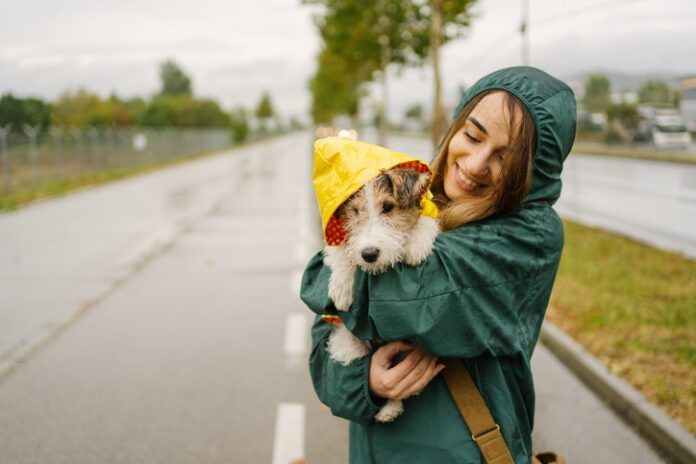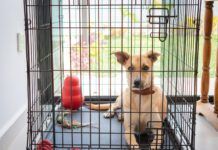A dog raincoat keeps your dog warm in cold, wet weather. If your dog is one of a single-coated breeds (such as Boxers, Dalmatians, Whippets, and Maltese), she lacks the insulating undercoat that helps maintain a comfortable body temperature when it’s cold out, and would benefit from a raincoat. Dogs with double coats (such as Labrador and Golden Retrievers, German Shepherds, and Siberian Huskies) have built-in under-layers to keep them warm, even when their outer coats are wet.
Breeds that might need a dog raincoat
It’s not just a dog’s natural coat that determines whether or not a dog raincoat might be necessary. It can be harder for toy breeds (such as Yorkshire Terriers and Chihuahuas) and short-coated breeds often known for being lean and/or muscular to generate enough heat to stay warm in cold or wet weather. Breeds such as the Whippets, Greyhounds, and the “bully” breeds (including American Pit Bull Terriers and American Staffordshire Terriers) can easily get chilled in damp weather, especially when not engaged in vigorous athletic activity.
Young puppies can also have a harder time staying warm in wet weather. Older dogs living with arthritic joints are more likely to be uncomfortable when cold, and any dog with a compromised immune system is more at risk of illness when exposed to prolonged wet weather.
Benefits of raincoats for short dogs
For short-legged breeds, well-designed dog raincoats offer another advantage: They help keep the undercarriage dry and clean! “Shorties” such as Dachshunds, Corgis, Bassett Hounds and French Bulldogs often have legs so short that their bellies easily come in contact with wet grass. Plus, since their legs don’t come with mud flaps, a brisk romp or walk in the rain can send mud and potentially contaminated runoff splashing up on their undersides. A raincoat that covers the chest and belly will help keep your short-legged friend clean and dry.
What to look for in a dog raincoat
When it comes to picking the right raincoat, one size definitely does not fit all. Here are some things to consider:
- Do you need to keep your dog dry, or warm and dry? Dog raincoats are available with and without an insulating layer.
- Water-resistant or water-repellent? Water-resistant fabrics can resist water to some degree, but not entirely. If worn in rain long enough, or in heavy rain, water will soak through. Water-repellant fabrics are typically treated with a coating designed to repel water, making them less penetrable by rain.
- Does the raincoat perform as expected? We recommend carefully reading product reviews if not making a purchase based on first-hand knowledge or a trusted referral.
- Look for a raincoat that comes in a wide range of sizes to help ensure a proper fit. A well-fitting raincoat should not restrict your dog’s movement or impede her vision. Hoods are generally more decorative than they are functional. Straps should be wide (so they’re less likely to move around) and not rest in your dog’s “armpits” where they’d be more likely to chafe – especially if water leaks in and the dog is damp.
- “City dogs” on short potty walks have different needs than “country dogs,” who might be more likely to wear the raincoat while romping through wide-open spaces. For the latter, we recommend looking for a raincoat made from a durable material, such as rip-stop nylon.
- Does the raincoat easily accommodate a leash or, if necessary, a harness, without compromising the coat’s ability to keep the dog dry?
- How does the raincoat go on the dog? Some styles feature leg holes the dog steps into versus draping over the dog. Fearful dogs, or dogs unfamiliar with wearing clothes, may find it harder to cooperate with leg holes.
- Dog raincoats secured by Velcro-type closures or quick-release buckles are easier to work with than zippers or snaps — especially on an excited dog waiting for a walk.
- When asking your dog to wear anything other than their natural coat, a little training can help ensure a positive experience.
When rain is in the forecast, a raincoat can help keep your pup happy, healthy and ready for outdoor adventures— be it around the block, through the park, or on the trails!






